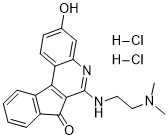TAS-103 dihydrochloride (also known as BMS-247615) is a potent and dual inhibitor of DNA topoisomerase I/II. In tumor models from mice and humans, this derivative of quinoline exhibits antitumor activity. TAS-103 has an IC50 value of 5 nM and is active on CCRF-CEM cells. In individual CCRF-CEM cells, TAS-103 at 0.1 μM significantly increases levels of topo IIα FITC immunofluorescence. HeLa cell viability is inhibited by TAS-103, with an IC50 of 40 nM. At 10 μM, TAS-103 prevents the formation of signal recognition particle (SRP) complexes and causes SRP14 and SRP19 to become unstable, leading to their eventual degradation. Despite the fact that TAS-103 has been described as a strong topoisomerase II poison. Nonetheless, alternative research has demonstrated that there is no association between topoisomerase II expression and cellular susceptibility to TAS-103.
Physicochemical Properties
| Molecular Formula | C20H21CL2N3O2 | |
| Molecular Weight | 406.31 | |
| Exact Mass | 405.101 | |
| Elemental Analysis | C, 59.12; H, 5.21; Cl, 17.45; N, 10.34; O, 7.88 | |
| CAS # | 174634-09-4 | |
| Related CAS # |
|
|
| PubChem CID | 135413532 | |
| Appearance | Red solid powder | |
| Boiling Point | 564ºC at 760mmHg | |
| Flash Point | 294.9ºC | |
| Vapour Pressure | 9.56E-13mmHg at 25°C | |
| LogP | 4.39 | |
| Hydrogen Bond Donor Count | 4 | |
| Hydrogen Bond Acceptor Count | 5 | |
| Rotatable Bond Count | 4 | |
| Heavy Atom Count | 27 | |
| Complexity | 497 | |
| Defined Atom Stereocenter Count | 0 | |
| SMILES | Cl[H].Cl[H].O=C1C2=C([H])C([H])=C([H])C([H])=C2C2C3C([H])=C([H])C(=C([H])C=3N=C(C=21)N([H])C([H])([H])C([H])([H])N(C([H])([H])[H])C([H])([H])[H])O[H] |
|
| InChi Key | HAYAYGFVSIWSGQ-UHFFFAOYSA-N | |
| InChi Code | InChI=1S/C20H19N3O2.2ClH/c1-23(2)10-9-21-20-18-17(13-5-3-4-6-14(13)19(18)25)15-8-7-12(24)11-16(15)22-20;;/h3-8,11,24H,9-10H2,1-2H3,(H,21,22);2*1H | |
| Chemical Name | 6-[2-(dimethylamino)ethylamino]-3-hydroxyindeno[2,1-c]quinolin-7-one;dihydrochloride | |
| Synonyms |
|
|
| HS Tariff Code | 2934.99.9001 | |
| Storage |
Powder-20°C 3 years 4°C 2 years In solvent -80°C 6 months -20°C 1 month Note: Please store this product in a sealed and protected environment, avoid exposure to moisture. |
|
| Shipping Condition | Room temperature (This product is stable at ambient temperature for a few days during ordinary shipping and time spent in Customs) |
Biological Activity
| Targets | Topoisomerase II; Topoisomerase I | |
| ln Vitro |
|
|
| ln Vivo |
|
|
| Cell Assay | Human acute lymphoblastic leukemia cells, designated as CCRF-CEM cells, are cultured in RPMI-1640 medium supplemented with 3 mM l-glutamine, 10% foetal bovine serum, 50 U/mL penicillin, and 40 μg/mL streptomycin. The culture is maintained at 37°C in a humidified environment with 5% CO2. In DMSO, TAS-103, CPT, and DACA are dissolved. Both drugs are applied to exponentially growing cells (approximately 5 × 105) for a duration of 2 hours. After being exposed to drugs, cells are centrifuged twice for three minutes at 400 × g in cold phosphate-buffered saline[1]. | |
| Animal Protocol |
|
|
| References |
[1]. An investigation into the formation of N- [2-(dimethylamino)ethyl]acridine-4-carboxamide (DACA) and 6-[2-(dimethylamino)ethylamino]- 3-hydroxy-7H-indeno[2, 1-C]quinolin-7-one dihydrochloride (TAS-103) stabilised DNA topoisomerase I and II cleavable complexes in human leukaemia cells. Biochem Pharmacol. 2000 Sep 15;60(6):817-21. [2]. Cancer chemotherapy by liposomal 6-[12-(dimethylamino)ethyl]aminol-3-hydroxy-7H-indeno[2,1-clquinolin-7-one dihydrochloride (TAS-103), a novel anti-cancer agent. Biol Pharm Bull. 2002 Oct;25(10):1385-7. [3]. A new mechanism of 6-((2-(dimethylamino)ethyl)amino)-3-hydroxy-7H-indeno(2,1-c)quinolin-7-one dihydrochloride (TAS-103) action discovered by target screening with drug-immobilized affinity beads. Mol Pharmacol. 2008 Mar;73(3):987-94. |
|
| Additional Infomation | TAS-103 is a quinoline derivative that inhibits both topoisomerase I and II, causing a cytotoxic effect in cancer cells. (NCI) |
Solubility Data
| Solubility (In Vitro) |
|
|||
| Solubility (In Vivo) |
Solubility in Formulation 1: 3.57 mg/mL (8.79 mM) in PBS (add these co-solvents sequentially from left to right, and one by one), clear solution; with sonication (<60°C). (Please use freshly prepared in vivo formulations for optimal results.) |
| Preparing Stock Solutions | 1 mg | 5 mg | 10 mg | |
| 1 mM | 2.4612 mL | 12.3059 mL | 24.6117 mL | |
| 5 mM | 0.4922 mL | 2.4612 mL | 4.9223 mL | |
| 10 mM | 0.2461 mL | 1.2306 mL | 2.4612 mL |
